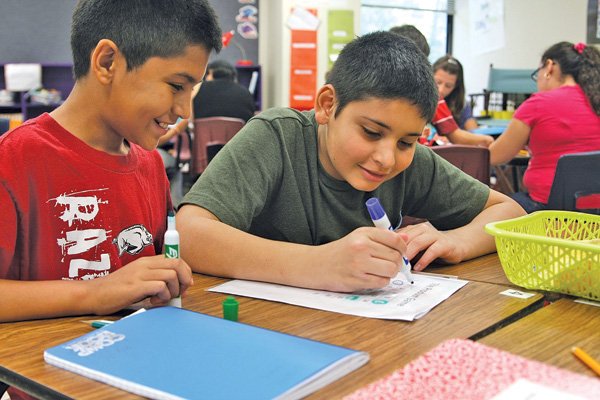ROGERS — Sixth-grade curriculum got a makeover in reading and math classes this fall in Rogers schools.
Reading class will be more structured while math classes will be less about repeating formulas and more about discovery, administrators said.
Both changes are aimed at teaching students to think.
Changes in middle school reading and math will roll into seventh and eighth grades during the next two years, said Roger Moore, assistant superintendent for secondary curriculum and instruction. Moore was charged with standardizing reading curriculum and reviewing middle school math curriculum when he took the position this year.
Reading changes were done in-house. The district purchased Connected Mathematics Project 3 because it aligns with Common Core and the hands-on math approach Rogers has emphasized for the past several years.
AT A GLANCE
What’s New?
In Math
Sixth-grade classes in Rogers changed to the Connected Mathematics Project 3 curriculum this year. The inquiry-based program uses problems to teach children about math.
In Reading
Sixth-grade classes in Rogers changed a unified reading curriculum this year. The new program sets vocabulary goals and adds non-fiction reading skills required by the Common Core standards.
Source: Staff Report
Benchmark tests are scheduled to be replaced by the Partnership for Assessment of Readiness for College and Careers test in the 2014-15 school year. The new tests will not just look at what students know, but if they can apply it in unfamiliar situations, said Candice Kindrick, secondary curriculum specialist.
Math teachers are being trained to launch lessons with a task that has a lot of math inside it. Students, sometimes working in teams, are asked what they think will lead to the answer, then the group discusses what they’ve learned.
“It’s been a lot of investigations with the kids,” Kindrick said.
That experience looked a lot like a game in Jean Ogden’s classroom Friday. Students paired up and played a type of numeric tic-tac-toe, trying to solve math problems and outstrategize their classmates.
The idea is to pose a problem that students don’t already know the answer to and get them to start solving it on their own.
“They do it first without really knowing what they’re doing,” Ogden said.
Discussion questions came from the game they had just played. Concepts like perfect squares and multiples will come out of Friday’s activity, Ogden said.
Sometimes students ask her to give them the answer to a simple math question, Ogden said. She asks them to find a way to show her.
Instead of drilling an answer into her students she wants them to make a connection between what they know and what they’re learning.
“It allows them to develop their own understanding of something,” she said.
Students will use more tools like tape measures and stop watches to gather information, Kindrick said. They might bring in a cylinder, like a soup can, and compare it against a set of classroom cubes. Students don’t have individual books in the math curriculum, but share classroom sets. Books are thinner since each is based on a single unit.
There are drill and practice problems, but parents are less likely to see homework made of worksheets this year, Kindrick said. Homework could be a broad real-life problem with more than one way to get the answer, Ogden said.
“It’s going to be different for parents who are used to sitting down with their kid and doing that rote memorization,” Kindrick said.
Reading curriculum also will change. Prior to this year, Rogers did not have a cohesive reading curriculum across all buildings in middle school, Moore said. Classes were different from building to building and the content was driven by English class. Now students will learn to read complex texts, Moore said.
“Reading in the past, it wasn’t as skills-based,” said Dana Ray, academic facilitator at Kirksey Middle School.
Common Core standards put more emphasis on nonfiction, especially as students get older. Those reading skills can be different, Ray said. Students will learn to take notes on what they read, to read picture captions, information boxes and understand graphs. Those skills will prepare them to be good adult readers, she said.
Not all their reading will be nonfiction. Students will still have books they picked out as part of reading class, Ray said, and they will talk about what they like to read.
Last year’s reading classes were taught by teachers who might also teach English, science or social science. This year reading teachers teach reading classes.
They also will compare and contrast themes and pull information together from several sources. The concept of claims and evidence, what an author says and how he or she builds a case, is central to Common Core standards. Every classroom will have vocabulary goals.
The new tests will ask for analytical thinking, even in reading.
“That’s the biggest difference I’ve seen – deep thinking,” Ray said.

